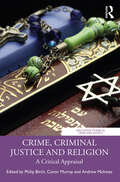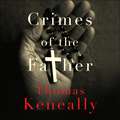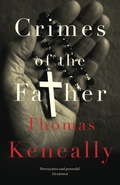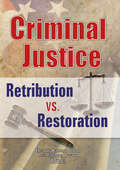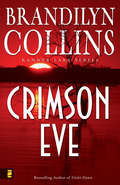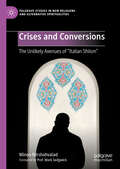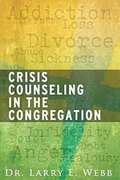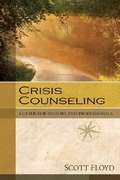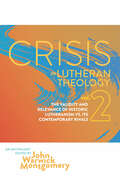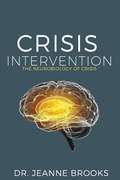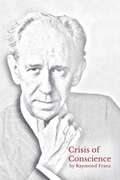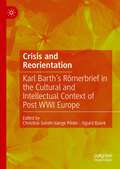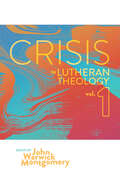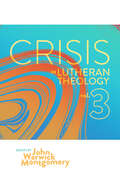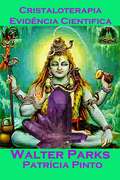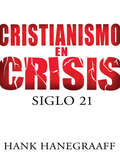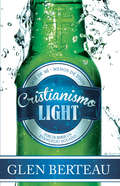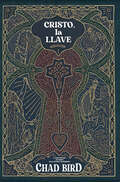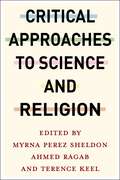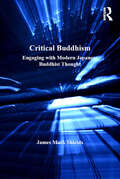- Table View
- List View
Crime, Criminal Justice and Religion: A Critical Appraisal (Routledge Studies in Crime and Society)
by Philip Birch Andrew McInnes Conor MurrayCrime, Criminal Justice and Religion: A Critical Appraisal seeks to bridge a gap in the examination of crime and criminal justice by taking both a historical and a contemporary lens to explore the influence of religion. Offering unique perspectives that consider the impact on modern-day policy and practice, the book scrutinises a range of issues such as abortion, hate crime and desistance as well as reflecting upon the influence religion can have on criminal justice professions. The book acts to renew the importance of, and recognise, the influence and impact religion has in terms of how we view and ultimately address crime and deliver criminal justice. One of the first books to cover the area of crime, criminal justice and religion, the book is split into three parts, with part 1 - 'Contextualising Crime, Criminal Justice and Religion' - providing an introduction to crime, criminal justice and religion, and reflections on the role religion has had, and continues to have, in how crime is understood and how we respond to it. Part 2 - 'Appraisal of Institutions and Professional Practice' - considers the issue of religion through institutions and professions of criminal justice, such as the police and legal profession, while part 3 - 'Appraisal of Contemporary Issues' - explores a range of crime and criminal justice issues in on which religion has had an impact, such as the death penalty and terrorism. Crime, Criminal Justice and Religion will be of primary interest to academics, researchers and students in criminology, law, sociology, psychology, social policy and related Humanities, Arts and Social Sciences disciplines. It will also be of interest to theologians, both as scholars and practitioners. The book is a body of work that will appeal at an international level and will also be a key resource for a range of practitioners across the globe working on issues concerning crime and criminal justice.
Crimes of the Father
by Thomas KeneallyThomas Keneally pulls no punches in this powerful novel about the Catholic Church's attempts to cover up cases of child abuse, and a priest who decides help its innocent victims' fight to be heard.Expelled from the archdiocese of Sydney as a young priest for his outspoken views on the Vietnam War, Father Frank Docherty returns to Australia in 1996 to speak at a conference on paedophilia within the Catholic Church. He had hoped to spend time with his mother and old friends. Instead, he finds himself caught up in the cases of two people who claim to have been sexually abused by an eminent Sydney cleric - one the son of Docherty's former parishioner, the other a former nun. And the cleric in question is brother to the woman Docherty fell in love with many years before. If the accusations are true, the consequences for many will be devastating, but Docherty has to follow his conscience. In this riveting, profoundly thoughtful novel, Thomas Keneally draws on his own experience as an ex-seminarian to bring alive matters of faith, celibacy, perversion and marriage. Portraying the Catholic Church at a pivotal moment, he shows that its prevarications and cover-ups wreaked terrible damage not only on innocents but on itself, with toxic repercussions to this day.(P)2017 Bolinda Publishing Pty Ltd
Crimes of the Father: A Novel
by Thomas KeneallyThomas Keneally pulls no punches in this powerful novel about the Catholic Church's attempts to cover up cases of child abuse, and a priest who decides to help its innocent victims' fight to be heard.Expelled from the archdiocese of Sydney as a young priest for his outspoken views on the Vietnam War, Father Frank Docherty returns to Australia in 1996 to speak at a conference on paedophilia within the Catholic Church. He had hoped to spend time with his mother and old friends. Instead, he finds himself caught up in the cases of two people who claim to have been sexually abused by an eminent Sydney cleric - one the son of Docherty's former parishioner, the other a former nun. And the cleric in question is brother to the woman Docherty fell in love with many years before. If the accusations are true, the consequences for many will be devastating, but Docherty has to follow his conscience. In this riveting, profoundly thoughtful novel, Thomas Keneally draws on his own experience as an ex-seminarian to bring alive matters of faith, celibacy, perversion and marriage. Portraying the Catholic Church at a pivotal moment, he shows that its prevarications and cover-ups wreaked terrible damage not only on innocents but on itself, with toxic repercussions to this day.
Criminal Justice: Retribution vs. Restoration
by Eleanor Hannon JudahThere are nearly two million inmates in America today. Are there better alternatives to incarceration? Criminal Justice: Retribution vs. Restoration presents new answers and unconventional suggestions addressing America&’s overcrowded prisons and jails, high recidivism rates, and weakened family and community relationships with ex-prisoners. Experts in the field discuss the benefits and failures of America&’s criminal justice system at various times in history and today, then explore possibilities to improve on that system. This groundbreaking book introduces encouraging, therapeutic approaches to criminal justice that include treatment, rehabilitation, and the direct involvement the victims, the families, and the communities. Criminal Justice looks at America&’s over-reliance on punishment and retribution as the means of responding to prevalent social problems and examines the justice system&’s tendency to incarcerate-rather than treat-minority, mentally ill, poor, and drug-dependent offenders. The authors-who are all active in some field of criminal justice-argue for a restorative model of correction that is more humane to both offenders and victims. This model opens up dialogue between offenders and their victims, families, and communities by promoting hallmark programs, including victim offender mediation, conferencing, peacemaking circles, restitution, and community projects and services. Criminal Justice includes such intriguing topics as: the social costs and moral economy of incarceration drug policy-should drug users be incarcerated or rehabilitated? the potential of restorative justice-a first-hand account from a prison inmate restorative justice and faith communities the practice and efficacy of restorative justice the path from fury to forgiveness-the emotions of the mother of a murdered child strategies for creating safe and just communities women in prison-their special needs both during incarceration and after re-entry social work and criminal justice-how they work together grassroots advocacy for criminal justice reform-a look back over the last 30 years by the founders of CURE (Citizens United for Rehabilitation of Errants) This book&’s foundation rests on the Biblical concepts of restoration, healing, forgiveness, reconciliation, and responsibility. Criminal Justice: Retribution vs Restoration is an eye-opening look at the negative effects of our current system of blame and punishment and offers hope for better, more humane methods in the future. This holistic, empowering, and strengths-based perspective offers insight and suggestions that are valuable for students, social workers, policymakers, and criminal justice professionals.
Crimson Eve
by Brandilyn CollinsIn book three of the Kanner Lake Series, the secluded beauty of northern Idaho offers no permanent hiding place from the past for Carla Radling. The secret from her teenage years has caught up with her'and now Carla's life and the nation's future hinge on a lethal game of hide-and-seek.
Crimson Mountain (The Grace Livingston Hill Classics series #15)
by Grace Livingston HillCrimson Mountain was burning! When the room in which Laurel Sheridan slept soundly was rocked by explosions, she awoke suddenly. Her heart sank as she saw that Crimson Mountain appeared to be burning. She feared that the defense plant had been destroyed by treacherous enemies. Her compassion went out to the loved ones of the young soldiers who had guarded the site so bravely. However, she was unaware that her beloved, captain Phil Pilgrim, was in charge. A student informed her that the injured, brave soldier was last seen heading back into the inferno, endeavoring to rescue more wounded men. As she worked in the kitchen helping to make sandwiches for the men and boys who joined in the rescue efforts, Laurel prayed for Phil. She heard reports of the dead and wounded men who had been carried down from crimson Mountain, but no one was certain of Phil's whereabouts. Late that evening, after the siege had finally ended, the doorbell rang. As she went to answer the door, Laurel's hope was laced with dread. Did the caller bring good news, or bad? Would she ever see Phil Pilgrim again? According to the Tyndale numbering this is book #85. Look in the Bookshare library for these novels by Grace Livingston Hill: #1. Where Two Ways Met, #2. Bright Arrows, #3. A Girl to Come Home to, #13. In Tune with Wedding Bells, #15. Marigold, #18. Brentwood, #19. Daphne Deane, #24. By way of the Silverthorns, #26. The Seventh Hour, #30. Matched Pearls, #33. Happiness Hill, #36. Patricia, #38. Spice Box, #41. blue ruin, #42. A New Name, #47. The Street of the City, #50. The Finding of Jasper Holt, #55. Ladybird, #60. Miranda, #61. Mystery Flowers, #66. The Girl From Montana, #68. The Story of a Whim, #70. in the way, #71. exit Betty, #72. The White Lady, #73. Not Under the Law, #74. Lo Michael, #76. The City of Fire, #77. The Ransom, #81. Duskin, #84. Cloudy Jewel, #85. Crimson Mountain, #93. Katharine’s yesterday, #94 The Angel of His Presence, #95. Mary Arden and #96. because of Stephen. Many more are on the way. Some of these may have different numbers depending on the publisher.
Crimson Roses (Grace Livingston Hill Series #10)
by Grace Livingston HillCRIMSON ROSES is the heartwarming story of a lonely girl whose love for a wealthy man arouses the dangerous envy of a society beauty... The story of a generous spirit who discovers in adversity and despair the power of her faith and love. Through the characters, the author explored Christian themes.
Crises and Conversions: The Unlikely Avenues of "Italian Shiism" (Palgrave Studies in New Religions and Alternative Spiritualities)
by Minoo MirshahvaladThis book explores the phenomenon of conversion to Shi'a Islam in Italy. It thoroughly examines the motivations behind this religious transition and scrutinizes the doctrinal characteristics that Shiism incorporates thanks to the contributions of Italian converts. The text emphasizes the significance of René Guénon’s Traditionalism as a pivotal factor in driving this religious mobility. Additionally, the book delves into the writings of figures such as Julius Evola, who introduced Guénon to Italy, shedding light on Evola’s impact on the youth in the post-World War II era. Furthermore, it evaluates the influence of Henry Corbin on this spiritual journey. To realize this study, between 2018 and 2023, Minoo Mirshahvalad employed multidisciplinary methods that integrated sociology and history.
Crisis Counseling in the Congregation
by Larry E. WebbEvery pastor knows that each community of faith consists of individuals who may be in crisis at any given moment, for a multitude of reasons. However, it’s essential that church leaders also view their congregations as a single organism in need of looking after as a whole. This book explores the core competencies, skills, and knowledge available to and needed by pastors so that they can provide suitable care for the most common needs of their members.Crisis Counseling in the Congregation provides a basic tool kit including in-depth listening skill, helping questions, various frameworks, and when to refer. Pastors will also benefit from the suggested reading list.
Crisis Counseling: A Guide for Pastors and Professionals
by Scott FloydDr. Floyd helps readers understand the nature of crises events, how individuals are impacted, and how to best provide help during and following times of trauma, loss, and grief.
Crisis In Lutheran Theology, Vol. 2: The Validity & Relevance of Historic Lutheranism vs. Its Contemporary Rivals (Crisis in Lutheran Theology)
by John Warwick MontgomeryAll Three volumes deal with the issue of biblical inerrancy (that the Bible is completely true and accurate, not only when it speaks to ideas of religious belief, but also when it speaks about factual elements of history and science, properly understood). This issue rocked the Lutheran Church Missouri Synod back in the late 1960s and early 1970s, prompting the release of the first two volumes. Volume one consists of essays by John Warwick Montgomery himself, and is addressed primarily to theologians. Volume two consists of an anthology by eight separate Lutheran contributors and is addressed to laymen as well as professional theologians. Volume 3 is new, never before published material and consists of essays by Dr. Montgomery outlining a new challenge along the same lines. Dr. Jeffery Kloha suggested a few years ago with the latest critical edition of the New Testament (Nestle-Aland 28th Edition), because of the interchangeability of some variant readings, that we now had a "plastic text". Dr. Montgomery goes up against this assertion with everything he has. Though obviously addressing themselves primarily to Lutheranism, the materials are, to a large degree, equally applicable to many of the other Christian communions and will be found to be extremely valuable in assessing the needs of a variety of denominations.
Crisis Intervention: The Neurobiology Of Crisis
by Jeanne BrooksThis manual is meant to help people through crisis. The author has worked in the mental health field for over thirty years with a specialty in crisis and for the last ten years, she has been training counseling students in crisis intervention. Natural disasters, mass shootings, refugee crises, human sex trafficking, etc. show the growing need for individuals to be prepared to sit with others in their suffering. The need is growing, yet the workers are few. The author has recognized that more and more organizations, disciplines, and ministries are doing crisis intervention with little to no knowledge or understanding of the effects that working with people in crisis has on the crisis worker. This manual will help gain a better understanding of how trauma effects an individual, as well as how working with people in crisis can affect the interventionist. This information can help work more effectively by training the team members in self-sustainment. This Christian perspective of intervention will help crisis interventionist and the agency become more Christ-like in their approach by instilling a confidence and hope in the most horrific of circumstances, while still maintaining strong faith in the goodness of God. The preventative practices provided in this manual will help prevent burnout, compassion fatigue and vicarious trauma for crisis interventionist.
Crisis Of Conscience: The Story Of The Struggle Between Loyalty To God And Loyalty To One's Religion
by Jon Mitchell Deborah Dykstra David Henke Raymond FranzCrisis of Conscience presents the story of a struggle to prevent the erosion of a God-given freedom of conscience and the ensuing dilemma of choosing between loyalty to God and loyalty to one’s religion. Former member of the Governing Body of Jehovah’s Witnesses, Raymond Franz delivers a rare glimpse into the inner workings of the Watch Tower Society. In response to extraordinary events, Franz tells a unique account of the decision-making sessions of this religion’s inner council and the powerful, sometimes dramatic, impact their decisions have on Jehovah’s Witnesses. Crisis of Conscience offers a penetrating view of the supreme council of this organization, the Governing Body and their life altering power over human lives. While the events of Raymond Franz's departure from the Governing Body occurred in 1980, the organizational foundation and structure remains the same today, making this account relevant to a whole new generation. Content: Raymond Franz, formerly a Governing Body member of Jehovah’s Witnesses, shares an account that reveals the inner workings and the decision-making processes of that Body, offering a penetrating view of the life altering power they have over human lives. The final nine of his sixty years as one of Jehovah’s Witnesses were spent on this central executive council. Those years led to his crisis of conscience, which is the theme of this book. Based on the entire manuscript of Franz’s 2008 printing of Crisis of Conscience, this fifth edition 2018, also includes: •Foreword by David Henke, author of Spiritual Abuse Recovery Workbook, and founder of Watchmen Fellowship, Inc. — David Henke is a Christian apologist that specializes in the field of Jehovah's Witnesses, issues of mind control, spiritual abuse, and legalism. In addition to the above workbook, Henke has authored evangelistic and educational tracts, and articles. •Excerpts from Franz’s In Search of Christian Freedom — Crisis of Conscience references 30 pages from In Search of Christian Freedom in the footnotes; for the convenience of the reader, these pages have been added to Appendix B. •Where is the “Great Crowd” Serving God? by Jon A. Mitchell, a former secretary to the Governing Body — As a secretary to the Governing Body, and member of the Service Department, Mitchell observed events during and immediately after Raymond Franz’ resignation from the Governing Body and numerous people were moved, demoted or disfellowshipped. As a result Jon Mitchell authored a booklet called Where is The “Great Crowd” Serving God? This is an account of Jon’s observations and his personal research from 1980 to 1981 while serving at Brooklyn Bethel. This booklet has been included in its entirety in Appendix C. •Epilogue, The Copyright Owner’s Story by Deborah Dykstra — Former regular pioneer and temporary special pioneer, Deborah Dykstra tells her journey of discovering that Jehovah’s Witnesses were not the sound foundation that she thought they were, realizing instead that it is Jesus Christ himself that is the real “truth” and foundation to life as a Christian. Thereafter, she shares how she embarked on a 25 year friendship with Raymond and Cynthia Franz along with anecdotal stories about the Franz’ lives. Raymond Franz died in 2010, however in this re-publishing of Crisis of Conscience based on it’s very last printing in 2008, the authors story, heart and expressions of his love for God and his fellow man remain with us.
Crisis and Reorientation: Karl Barth’s Römerbrief in the Cultural and Intellectual Context of Post WWI Europe
by Sigurd Baark Christine Svinth-Værge PõderThis book uses Karl Barth’s Der Römerbrief (1922) as a prism through which to explore the role of religion and its interactions with cultural and political thought in the turbulent interwar period in Europe. One of the most influential books in twentieth-century protestant theology, Der Römerbrief found Barth arguing that the crisis of the time was grounded in an even more profound crisis that pertained to the human condition as such. While much research has been conducted on Der Römerbrief, most of it has focused on the book’s explicit theology. The aim of the present volume is to mark the centenary of this seminal book with a broader investigation into the movements of thought within Der Römerbrief and its reception and impact within its cultural and intellectual context. This broader approach by a range of Northern European researchers brings attention to interconnections between cultural and theological movements in times of crisis.
Crisis in Lutheran Theology, Vol. 1: The Validity & Relevance of Historic Lutheranism vs. Its Contemporary Rivals (Crisis in Lutheran Theology)
by John Warwick MontgomeryAll Three volumes deal with the issue of biblical inerrancy (that the Bible is completely true and accurate, not only when it speaks to ideas of religious belief, but also when it speaks about factual elements of history and science, properly understood). This issue rocked the Lutheran Church Missouri Synod back in the late 1960s and early 1970s, prompting the release of the first two volumes. Volume one consists of essays by John Warwick Montgomery himself, and is addressed primarily to theologians. Volume two consists of an anthology by eight separate Lutheran contributors and is addressed to laymen as well as professional theologians. Volume 3 is new, never before published material and consists of essays by Dr. Montgomery outlining a new challenge along the same lines. Dr. Jeffery Kloha suggested a few years ago with the latest critical edition of the New Testament (Nestle-Aland 28th Edition), because of the interchangeability of some variant readings, that we now had a "plastic text". Dr. Montgomery goes up against this assertion with everything he has. Though obviously addressing themselves primarily to Lutheranism, the materials are, to a large degree, equally applicable to many of the other Christian communions and will be found to be extremely valuable in assessing the needs of a variety of denominations.
Crisis in Lutheran Theology, Vol. 3: The Validity and Relevance of Historic Lutheranism vs. Its Contemporary Rivals (Crisis in Lutheran Theology)
by John Warwick MontgomeryAll Three volumes deal with the issue of biblical inerrancy (that the Bible is completely true and accurate, not only when it speaks to ideas of religious belief, but also when it speaks about factual elements of history and science, properly understood). This issue rocked the Lutheran Church Missouri Synod back in the late 1960s and early 1970s, prompting the release of the first two volumes. Volume one consists of essays by John Warwick Montgomery himself, and is addressed primarily to theologians. Volume two consists of an anthology by eight separate Lutheran contributors and is addressed to laymen as well as professional theologians. Volume 3 contains new, never before published material and consists of essays by Dr. Montgomery outlining a new challenge along the same lines. Dr. Jeffery Kloha suggested a few years ago with the latest critical edition of the New Testament (Nestle-Aland 28th Edition), because of the interchangeability of some variant readings, that we now had a "plastic text". Dr. Montgomery goes up against this assertion with everything he has. Though obviously addressing themselves primarily to Lutheranism, the materials are, to a large degree, equally applicable to many of the other Christian communions and will be found to be extremely valuable in assessing the needs of a variety of denominations.
Cristales Sanadores: Evidencia Científica
by Silvana Borghi Walter ParksHe escuchado toda mi vida sobre la sanación por cristales pero siempre lo consideré pura charlatanería. Un amigo, creyente él, me pidió que echara un vistazo y encontrara la base científica de esta terapia. Al haber cursado una carrera en ingeniería aeroespacial, él pensó que, seguramente podría encontrar la base científica de algo que él cree tan fuertemente. Sentí que tenía que comprobarlo por mi amigo. Me di cuenta de que cualquier base científica para la sanación a través de cristales tendría que requerir algún tipo de intercambio de energía entre el cristal y nuestro cuerpo. He evaluado varios tipos de cristales y encontré que la amatista tenía el mejor campo de energía mensurable con la mayoría de los datos disponibles. Sabía debido a la famosa ecuación de Einstein E = MC2 que nuestros cuerpos son básicamente dos tipos de matrices: una de materia (M) que es nuestra carne y hueso y otra de energía (E) que tiene un campo electromagnético cuantificable. (C es la velocidad de la luz). Sabía que los defensores de curación por cristales llamaban aura a este campo. El objetivo básico entonces era encontrar un mecanismo que permita a nuestros cuerpos recibir una transmisión energética desde un cristal radiante. He leído sobre los Vedas de la antigua religión hindú y he aprendido sobre sus creencias respecto de los chakras y en especial del Chakra llamado el Tercer Ojo. He investigado este tercer ojo y aprendí que nuestros antepasados, de hecho, tenían un tercer ojo que podía percibir frecuencias de vibraciones del entorno. Algunas criaturas primitivas que aún viven hoy en día lo tienen. Investigaciones posteriores revelaron que el tercer ojo de nuestros antepasados había evolucionado a nuestra glándula pineal actual. Investigué entonces que nuestra glándula pineal segrega una hormona que se ha convertido en el conduc
Cristaloterapia; Evidência Científica
by Patrícia Pinto Walter ParksA Evidência Científica prova que a Cristaloterapia funciona. Tenho ouvido falar de Cristaloterapia durante toda a minha vida, mas assumi que era charlatanismo. Um amigo meu, que era um crente, pediu-me para fazer uma investigação e para tentar encontrar uma base científica para a Cristaloterapia. A minha carreira profissional é a de Engenheiro Aeroespacial, por isso ele pensou que eu seria capaz de encontrar a base científica para algo em que ele acreditava com tanto afinco. Senti que tinha que fazer esse favor ao meu bom amigo. Percebi que qualquer uma que fosse a base científica para a Cristaloterapia iria requer algum tipo de troca de energia, entre o cristal e o nosso corpo humano. Avaliei vários tipos de cristais e descobri que a ametista tinha o melhor campo de energia mensurável e um maior número de dados mais disponíveis. Já sabia, a partir da famosa equação do Einstein E = MC2 que os nossos corpos são, basicamente, dois tipos de matrizes: uma é a matéria (M), que é a nossa carne e os ossos, e a outra é a energia (E), que tem um campo eletromagnético mensurável. C é a velocidade da luz. Também sabia que os defensores da Cristaloterapia chamam a esse campo de aura. O objetivo básico era, então, encontrar um mecanismo que permitisse aos nossos corpos receber uma transmissão de energia, vinda das irradiações de um cristal. Li artigos sobre os Vedas, da antiga religião hindu, e aprendi mais sobre as suas crenças, sobre os chacras e, especialmente, que chamavam ao chacra de terceiro olho. Estive a fazer investigações sobre esse terceiro olho e aprendi que os nossos ancestrais, de fato, tinham um terceiro olho que podia captar as vibrações do seu meio ambiente. Algumas criaturas primitivas, que ainda estão hoje vivas nos nossos dias, têm terceiros olhos. As investigações posteriores revelaram que o Terceiro Olho dos nossos antepassados
Cristianismo en crisis: Siglo 21
by Hank HanegraaffSin un cambio de percepción y perspectiva, la iglesia está en un horroroso peligro.El autor de gran éxito de ventas, Hank Hanegraaff, dice que una tendencia peligrosa está haciendo estragos en el cuerpo de Cristo. A menos que se le detenga ahora, las consecuencias para el cristianismo podrían ser catastróficas. Hanegraaff atestigua que el verdadero Cristo y la verdadera fe de la Biblia están siendo reemplazados rápidamente por sustitutos enfermos que ofrecen un grupo de maestros que pertenecen a lo que se le ha calificado como el "Movimiento de Fe". Muchos en el mundo han sido engañados por lo que se podría llamar "cristianismo estilo comida rápida": un cristianismo grande en apariencias pero pequeño en sustancia y popularizado por figuras reconocidas como Joyce Meyer, Paula White, Creflo Dollar y otros. "No todo lo que promueven estos maestros es erróneo", dice Hanegraaff. "Pero es el error fatal mezclado con la verdad lo que hace que este movimiento sea peligroso". Este libro se enfoca en estos errores potencialmente mortales y está lleno de estudios perspicaces de las Escrituras y sugerencias para la investigación personal.
Cristianismo light: Pare de beber un evangelio aguado
by Glen BerteauNecesitamos algo más que una fe diluida y descafeinada. NECESITAMOS LO AUTENTICO. Casi todos los alimentos y bebidas de hoy tienen una versión "light"; las papas fritas, la crema batida, el jarabe de arce, las gaseosas, las bebidas... Incluso puede que haya escuchado campañas publicitarias sobre algunos de estos donde aluden a un sabor "mas suave y liviano". Muchos de nosotros hemos adoptado esta misma actitud, algunas veces sin darnos cuenta, y lo aplicamos a nuestra fe. Queremos las bendiciones, pero sin la obediencia. La comodidad sin el sacrificio. La felicidad sin el arrepentimiento. Como resultado de esto, hemos aguado, descafeinado y diluido el mensaje del evangelio hasta llevarlo a no tener ningún efecto en nuestras vidas o la vida de otros. En Cristianismo Light, Glen Beteau nos hace un llamado al mensaje del evangelio completo; Jesús no vino para mejorar nuestras vidas normales, egoístas y pecaminosas. Vino para transformar radicalmente lo que conocemos. Este camino estrecho, el camino de la obediencia inspirada en la gracia, es el único camino para encontrar al verdadero Jesús, un verdadero significado, una esperanza real y una vida en la cual vivamos auténticamente.
Cristo, la llave: La centralidad de Cristo en el Antiguo Testamento
by Chad BirdLeer el Antiguo Testamento puede parecer como explorar una antigua y misteriosa mansió n, llena de toda clase de cuartos extrañ os. El cuarto de la creació n, amplio y sublime. El cuarto del é xodo, con faraones de corazó n empedernido y mares que se secan. El cuarto de la guerra, con espadas ensangrentadas y muros derribados. El cuarto del taberná culo, con altares humeantes y un oscuro lugar santí simo. ¿ Qué tiene que ver este curioso y antiguo mundo con nosotros los seguidores modernos de Jesú s? ¡ Resulta que tiene todo que ver! Cada capí tulo del Antiguo Testamento, de variadas formas, cuenta la historia que culmina en Jesú s el Mesí as.Lo que los cristianos hoy llaman el Antiguo Testamento es lo que Jesú s y los primeros creyentes llamaban las Escrituras. Esa era su Biblia. Desde sus pá ginas, ellos enseñ aron acerca de la naturaleza divina del Mesí as, su obra sacerdotal, su ministerio de salvació n. Cristo, la llave presentará una vez má s a los lectores estos antiguos libros como testimonios siempre frescos y novedosos de Jesú s. Al terminar, aun Leví tico te parecerá un libro de gracia y misericordia, y en los Salmos oirá s la potente voz de Cristo.
Critical Approaches to Science and Religion
by Sheldon, Myrna Perez; Ragab, Ahmed; Keel, TerenceCritical Approaches to Science and Religion offers a new direction for scholarship on science and religion that examines social, political, and ecological concerns long part of the field but never properly centered. The works that make up this volume are not preoccupied with traditional philosophical or theological issues. Instead, the book draws on three vital schools of thought: critical race theory, feminist and queer theory, and postcolonial theory. Featuring a diverse array of contributors, it develops critical perspectives by examining how histories of empire, slavery, colonialism, and patriarchy have shaped the many relationships between science and religion in the modern era. In so doing, this book lays the groundwork for scholars interested in speaking directly to matters such as climate change, structural racism, immigration, health care, reproductive justice, and sexual identity.
Critical Buddhism: Engaging with Modern Japanese Buddhist Thought (Routledge Critical Studies In Buddhism Ser.)
by James Mark ShieldsIn the late 1980s and early 1990s, the relative calm world of Japanese Buddhist scholarship was thrown into chaos with the publication of several works by Buddhist scholars Hakamaya Noriaki and Matsumoto Shiro, dedicated to the promotion of something they called Critical Buddhism (hihan bukkyo). In their quest to re-establish a "true" - rational, ethical and humanist - form of East Asian Buddhism, the Critical Buddhists undertook a radical deconstruction of historical and contemporary East Asian Buddhism, particularly Zen. While their controversial work has received some attention in English-language scholarship, this is the first book-length treatment of Critical Buddhism as both a philosophical and religious movement, where the lines between scholarship and practice blur. Providing a critical and constructive analysis of Critical Buddhism, particularly the epistemological categories of critica and topica, this book examines contemporary theories of knowledge and ethics in order to situate Critical Buddhism within modern Japanese and Buddhist thought as well as in relation to current trends in contemporary Western thought.
Critical Care (Mercy Hospital #1)
by Candace CalvertAFTER HER BROTHER DIES IN A TRAUMA ROOM, nurse Claire Avery can no longer face the ER. She's determined to make a fresh start—new hospital, new career in nursing education— move forward, no turning back. But her plans fall apart when she's called to offer stress counseling for medical staff after a heartbreaking day care center explosion. Worse, she's forced back to the ER, where she clashes with Logan Caldwell, a doctor who believes touchy-feely counseling is a waste of time. He demands his staff be as tough as he is. Yet he finds himself drawn to this nurse educator . . . who just might teach him the true meaning of healing.
